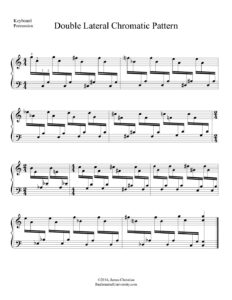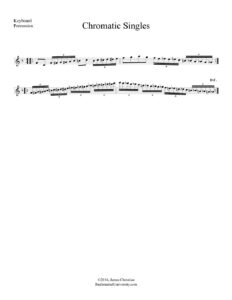
I live near the Dallas/Ft. Worth metroplex in Texas. One of the most popular drum line contests in this area is the Plano Drum Line Competition, which is held every year in September. In addition to offering the opportunity for dozens of drum lines to compete, Plano’s contest also features an individual & ensemble competition. For each instrument, there is a “compulsory” that is to be performed before the contestant’s solo. For snares and tenors, they must open and close a flam drag. For timpani, they must perform “My Country, ‘Tis of Thee” on a maximum of three drums. For four-mallet keyboard percussion, they are required to play the above double lateral exercise.
When I first saw this exercise, I really liked it. I wondered how the contest hosts had decided to use it. Well, this past year, I decided to start working through every exercise in Leigh Howard Stevens’ classic Method of Movement for Marimba. (Of course, I had played from various sections before, but never in such a focused and goal-oriented way. This time I was determined to play through the entire book.) Lo and behold, this exercise is in the book’s section on double laterals.
I offer this bit of personal background info just to let you know why this exercise has stuck with me. I’m glad it has. It really is a great exercise for working double laterals across the keyboard. I recommend starting it slowly until you feel confident in each position. It is probably easiest to memorize the pattern. Focus on striking the bars on the proper beating spots. Also take care that each note resonates at an equal volume. Don’t drop the second note of each lateral!
This exercise is obviously written for marimba, but it can also be played on xylophone and vibraphone. For xylophone, simply play the exercise an octave higher. For vibraphone, transpose the exercise up a minor seventh. That is, take it up an octave, and then take it down a whole step, so that your first four notes are F, B-flat, B-flat, F.

